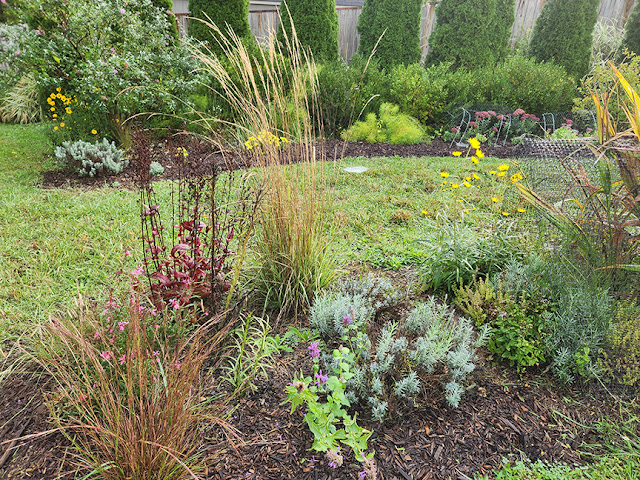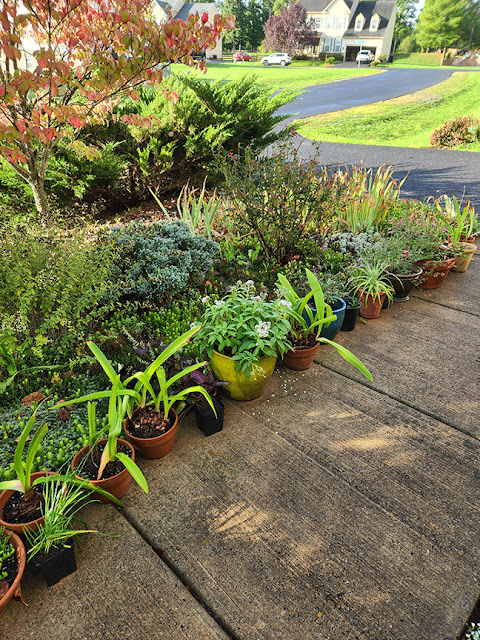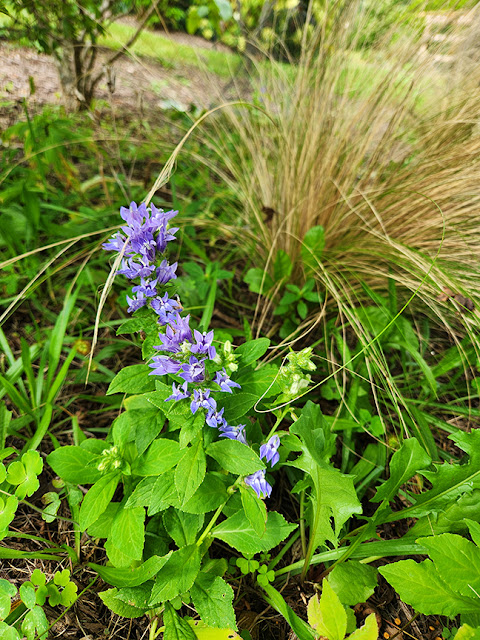 |
| Mushrooms growing under the birdbath. |
The past week's rains from hurricane Helene here in Virginia have been good for my garden, even it if comes a little late--the growing season is coming to its end. Mushrooms are sprouting in my flower beds, the spiders are busy weaving their lacy orbs, while the fall-flowering plants and bulbs are making their appearance.
 |
| Orange Chrysanthemum with Colchicum. |
 |
| Colchicum 'Waterlily' |
 |
| Colchicum 'Bornmuelleri' |
 |
| Back bed with Colchicum |
The Colchicum 'Waterlily' that I had planted a few years back put forth a couple of lovely flowers, which were torn to pieces by the deer shortly after I took this photo. Colchicums are poisonuous and most critters avoid them, which is why I chose this plant, but in this case it seems as if the deer tore my flowers up just out of spite (they didn't eat them), or was it perhaps to prevent their young from eating the tempting flowers? I'm never sure just how much intelligence to credit these creatures with.
The Colchicum 'Bornmuellerii' I planted in the back bed a couple of weeks ago popped up, but these have not been bothered at all. I'm waiting for the white Colchicum autumnale 'Album' I planted at the same time to come up any moment now, can't wait to see the flowers! I hope these will multiply over the years.
 |
| Muhly grass, Sedum 'Autumn Joy' and swamp sunflowers in Herb's bed. |
 |
| Gaura 'Butterflies' with Agastache 'Blue Boa' and Little Bluestem grass. |
Herb's bed really comes into its own in the fall, when the Muhly grass sets out its feathery plumes and the swamp sunflowers and 'Autumn Joy' Sedum put on their show.
 |
| Herb's bed with the Little Indians bed beyond. |
 |
| Looking toward the back yard from the west garden. |
The leaves of some trees are starting to show autumn color, the Yellowood tree (on the left) and the Redbud in the back. The dogwood in the front yard has turned a lovely orange.
 |
| Along the front walk. |
The rain stimulated the much chewed-up Ceanothus 'Gloire de Versailles' to re-bloom, but the Leatherleaf Viburnum in back that is in bud has not unfolded its flowers yet--I hope they'll bloom before our first frost gets them.
 |
| Ceanothus 'Gloire de Versailles' |
 |
| Leatherleaf Viburnum flower buds |
The Anemone 'Honorine Jobert' is pushing against its wire cage, attempting to extend its flower stems to their normal lofty height. Unfortunately, I know the deer will decimate it if I remove the protective wire cloche, so until I can come up with a more effective barrier, they will have to stay cramped--I took off the cover for the photo.
 |
| Anemone 'Honorine Jobert' |
After much browsing, the deer left me a few hardy Begonias in the front yard to bloom and re-seed themselves--not the display of other years, but I'll take it!
 |
| Hardy Begonias under the cherry tree in front. |
My east woodland garden has prospered with the rains, although the Pagoda dogwood has started dropping its leaves. The holly 'Nelly Stevens' is full of ripening berries this year.
 |
| Woodland garden in the east. |
 |
| 'Nelly Stevens' Holly and Osmanthus 'Goshiki' |
 |
| Woodland garden from the back yard. |
One casualty of the tropical storm winds was one of my front porch baskets, which pulled out the hook from the beam from which it hung. Herb was watching it spinning crazily in the wind when it finally broke. Fortunately, it seems to have made a soft landing on top of the greenery in front. I hope we can re-hang the hook later on, but for now it makes the porch look unbalanced.
 |
| Fallen porch basket. |
I wonder what October will bring... will we have a colorful autumn, and when will our first frost occur this year?


































